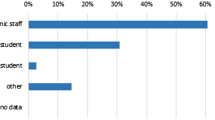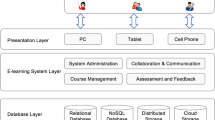Abstract
This paper investigates the possibilities in the area of application of mobile technologies for language learning. The primary goal is to design a mobile system for learning of the Japanese language with a clear separation of content and presentation, and to leverage the learners’ interest in the Japanese language. Both the technical and the language learning perspectives are discussed. A reusable, lightweight model of learning objects with compact content and a reduced metadata set is presented. These objects are stored in a simple learning object repository that can deliver them to any client over the Internet. A mobile application is designed to use the learning object repository as its content provider, while defining its own method of presentation suitable for smaller screens of mobile devices. For the purpose of evaluation, an experiment was conducted within the e-learning system at the Faculty of Organizational Sciences, University of Belgrade. Research findings have indicated that the developed mobile application has a positive effect on the students’ interest in the subject matter.
















Similar content being viewed by others
References
Adzic V, Kalva H, Furht B (2011) A survey of multimedia content adaptation for mobile devices. Multimedia Tools Appl 51:379–396. doi:10.1007/s11042-010-0669-x
Alexander PA (2003) The development of expertise: the journey from acclimation to proficiency. Educ Res 32:10–14. doi:10.3102/0013189X032008010
Ardito L, Procaccianti G, Torchiano M et al (2013) Profiling power consumption on mobile devices. ENERGY 2013, The Third International Conference on Smart Grids, Green Communications and IT Energy-aware Technologies. Lisbon, Portugal, pp 101–106
Arnone MP, Small RV, Chauncey SA, McKenna HP (2011) Curiosity, interest and engagement in technology-pervasive learning environments: a new research agenda. Educ Technol Res Dev 59:181–198. doi:10.1007/s11423-011-9190-9
Bogdanović Z, Barać D, Jovanić B et al (2013) Evaluation of mobile assessment in a learning management system. Br J Educ Technol. doi:10.1111/bjet.12015
Bradley C, Haynes R, Cook J et al (2008) Design and development of multimedia learning objects for mobile phones. In: Ally M (ed) Mobile learning in education and training. Athabasca University Press, Canada, pp 158–181
Carroll A, Heiser G (2010) An analysis of power consumption in a smartphone. Proceedings of the 2010 USENIX conference on USENIX annual technical conference. USENIX Association, Boston, MA, pp 21–34
Cheng S-C, Hwang W-Y, Wu S-Y et al (2010) A mobile device and online system with contextual familiarity and its effects on English learning on campus. Educ Technol Soc 13:93–109
Chinnery GM (2006) Emerging technologies: going to the MALL: mobile assisted language learning. Lang Learn Technol 10:9–16
Churchill D (2011) Conceptual model learning objects and design recommendations for small screens. Educ Technol Soc 14:203–216
Cisco Systems (1999) Cisco systems reusable information object strategy: definition, creation overview, and guidelines. pp 1–45
De Jong T, Specht M, Koper R (2009) A study of contextualised mobile information delivery for language learning. Educ Technol Soc 13:110–125
Despotović-Zrakić M, Marković A, Bogdanović Z et al (2012) Providing adaptivity in moodle LMS courses. Educ Technol Soc 15:326–338
Fallahkhair S, Pemberton L, Griffiths R (2007) Development of a cross-platform ubiquitous language learning service via mobile phone and interactive television. J Comput Assist Learn 23:312–325. doi:10.1111/j.1365-2729.2007.00236.x
Godwin-Jones R (2011) Emerging technologies: mobile apps for language learning. Lang Learn Technol 15:2–11
Gu X, Gu F, Laffey JM (2011) Designing a mobile system for lifelong learning on the move. J Comput Assist Learn 27:204–215. doi:10.1111/j.1365-2729.2010.00391.x
Hodgins H (2004) The future of learning objects. 2002 ECI Conference on e-Technologies in Engineering Education: Learning Outcomes Providing Future Possibilities
Holzinger A (2005) Usability engineering for software developers. Commun ACM 48:71–74
Holzinger A, Geier M, Germanakos P et al (2012) On the development of smart adaptive user interfaces for mobile e-business applications: Towards enhancing user experience—some lessons learned. In: Marca D (ed) Proceedings of the International Conference on e-Business (ICE-B). SciTec Press, Rome, pp 3–16
Holzinger A, Nischelwitzer A, Friedl S, Hu B (2010) Towards life long learning: three models for ubiquitous applications. Wirel Commun Mob Comput 10:1350–1365
Holzinger A, Treitler P, Slany W (2012) Making apps useable on multiple different mobile platforms: On interoperability for business application development on smart phones. In: Quirchmayr G, Basl J, You I et al (eds) Multidisciplinary research and practice for information systems. Springer, Berlin Heidelberg, pp 176–189
Hwang G-J, Tsai C-C (2011) Research trends in mobile and ubiquitous learning: a review of publications in selected journals from 2001 to 2010. Br J Educ Technol 42:E65–E70. doi:10.1111/j.1467-8535.2011.01183.x
IEEE Learning Technology Standards Committee (2002) Draft standard for learning object metadata. pp 1–44
IEEE Learning Technology Standards Committee (2005) IEEE Standard for Learning Technology—Extensible Markup Language (XML) Schema Definition Language Binding for Learning Object Metadata
Joseph SRH, Uther M (2009) Mobile devices for language learning: multimedia approaches. Res Pract Technol Enhanc Learn 4:7–32. doi:10.1142/S179320680900060X
Klopfer E, Sheldon J, Perry J, Chen VH-H (2012) Ubiquitous games for learning (UbiqGames): Weatherlings, a worked example. J Comput Assist Learn 28:465–476. doi:10.1111/j.1365-2729.2011.00456.x
Konstantinidis A, Tsiatsos T, Pomportsis A (2009) Collaborative virtual learning environments: design and evaluation. Multimedia Tools Appl 44:279–304. doi:10.1007/s11042-009-0289-5
L’Allier JJ (1997) Frame of reference: NETg’s map to the products, their structure and core beliefs
Lawless K, Brown S, Mills R, Mayall H (2003) Knowledge, interest, recall and navigation: a look at hypertext processing. J Lit Res 35:911–934. doi:10.1207/s15548430jlr3503_5
Lawless K, Kulikowich J (2006) Domain knowledge and individual interest: the effects of academic level and specialization in statistics and psychology. Contemp Educ Psychol 31:30–43. doi:10.1016/j.cedpsych.2005.01.002
Longmire W (2000) A primer on learning objects. Learn Circ 1–5
Looi C-K, Seow P, Zhang B et al (2010) Leveraging mobile technology for sustainable seamless learning: a research agenda. Br J Educ Technol 41:154–169. doi:10.1111/j.1467-8535.2008.00912.x
Matsuo K, Kato C, Okada T et al (2003) Finger movements lighten neural loads in the recognition of ideographic characters. Cogn Brain Res 17:263–272. doi:10.1016/S0926-6410(03)00114-9
McGreal R (2004) Learning objects: a practical definition. Int J Instr Technol Dist Learn 1:21–32
Moreno-Ger P, Burgos D, Martínez-Ortiz I et al (2008) Educational game design for online education. Comput Hum Behav 24:2530–2540. doi:10.1016/j.chb.2008.03.012
Motschnig-Pitrik R, Holzinger A (2002) Student-centered teaching meets new media: concept and case study. Educ Technol Soc 5:160–172
Mujacic S, Debevc M, Kosec P et al (2012) Modeling, design, development and evaluation of a hypervideo application for digital systems teaching. Multimedia Tools Appl 58:435–452
Ogata H, Yano Y (2003) How ubiquitous computing can support language learning. Proceedings of KEST. pp 1–6
Okan Z (2003) Edutainment: is learning at risk? Br J Educ Technol 34:255–264. doi:10.1111/1467-8535.00325
Palit R, Arya R, Naik K, Singh A (2011) Selection and execution of user level test cases for energy cost evaluation of smartphones. Proceeding of the 6th international workshop on Automation of software test—AST’11. ACM Press, Waikiki, Honolulu, HI, USA, pp 84–90
Paymans TF, Lindenberg J, Neerincx M (2004) Usability trade-offs for adaptive user interfaces. Proceedings of the 9th international conference on Intelligent user interface - IUI’04. ACM Press, New York, New York, USA, pp 301–303
Polsani P (2003) Use and abuse of reusable learning objects. J Digit Inf 3. http://journals.tdl.org/jodi/index.php/jodi/article/view/89/88. Accessed 21 Sep 2013
Sandberg J, Maris M, de Geus K (2011) Mobile english learning: an evidence-based study with fifth graders. Comput Educ 57:1334–1347. doi:10.1016/j.compedu.2011.01.015
Schandl B, Haslhofer B, Bürger T et al (2011) Linked data and multimedia: the state of affairs. Multimedia Tools Appl 59:523–556. doi:10.1007/s11042-011-0762-9
Sha L, Looi C-K, Chen W, Zhang BH (2012) Understanding mobile learning from the perspective of self-regulated learning. J Comput Assist Learn 28:366–378. doi:10.1111/j.1365-2729.2011.00461.x
Stockwell G (2010) Using mobile phones for vocabulary activities: examining the effect of the platform. Lang Learn Technol 14:95–110
Tsai C, Kuo C-H, Horng W-B, Chen C-W (2012) Effects on learning logographic character formation in computer-assisted handwriting instruction. Lang Learn Technol 16:110–130
Vidas T, Zhang C, Christin N (2011) Toward a general collection methodology for Android devices. Digit Investig Int J Digit Forensic Incident Respon 8:S14–S24. doi:10.1016/j.diin.2011.05.003
Wang M, Shen R, Novak D, Pan X (2009) The impact of mobile learning on students’ learning behaviours and performance: report from a large blended classroom. Br J Educ Technol 40:673–695. doi:10.1111/j.1467-8535.2008.00846.x
Wong L-H, Looi C-K (2010) Vocabulary learning by mobile-assisted authentic content creation and social meaning-making: two case studies. J Comput Assist Learn 26:421–433. doi:10.1111/j.1365-2729.2010.00357.x
Acknowledgments
The authors are thankful to the Ministry of Education, Science, and Technological Development of the Republic of Serbia, Grant no.174031.
Author information
Authors and Affiliations
Corresponding author
Rights and permissions
About this article
Cite this article
Milutinović, M., Labus, A., Stojiljković, V. et al. Designing a mobile language learning system based on lightweight learning objects. Multimed Tools Appl 74, 903–935 (2015). https://doi.org/10.1007/s11042-013-1704-5
Published:
Issue Date:
DOI: https://doi.org/10.1007/s11042-013-1704-5




